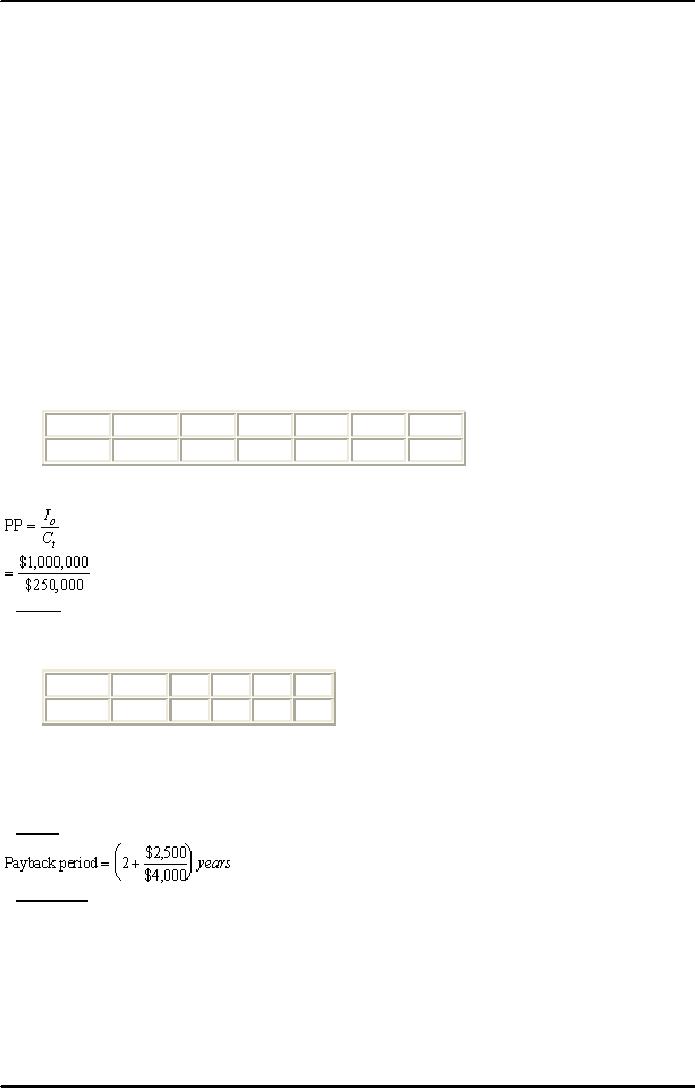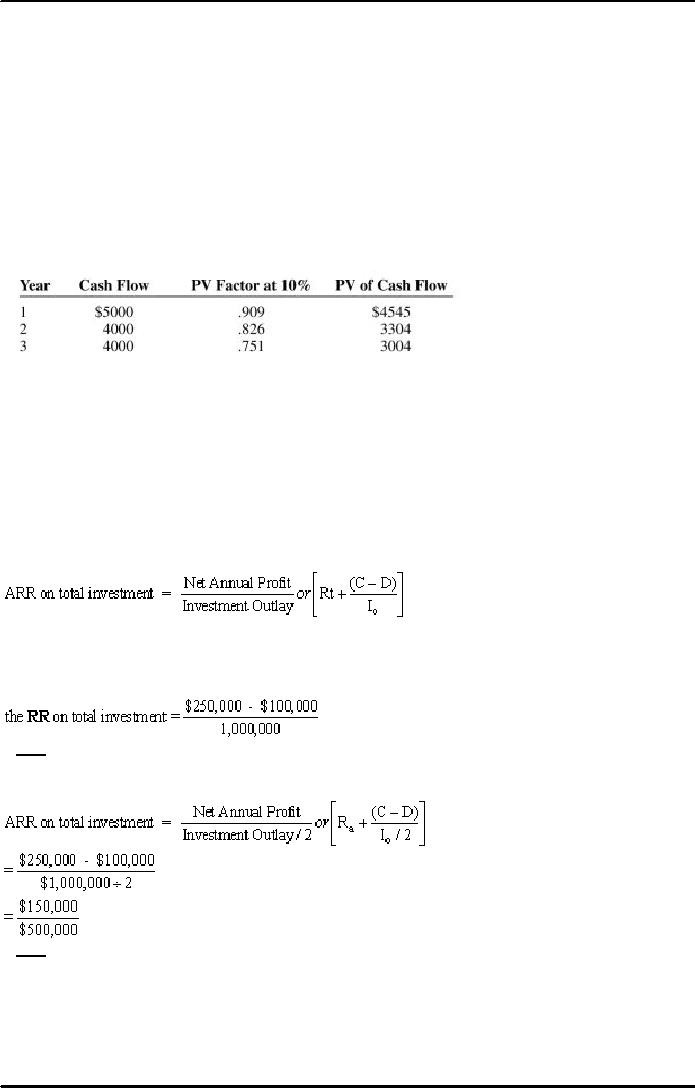 |
METHODS OF PROJECT EVALUATIONS 3 |
| << METHODS OF PROJECT EVALUATIONS 2 |
| ADVANCE EVALUATION METHODS: Sensitivity analysis, Profitability analysis, Break even accounting, Break even - economic >> |

Corporate
Finance FIN 622
VU
Lesson
11
METHODS
OF PROJECT EVALUATIONS
The
following topics will be
discussed in this hand out.
Methods
of Project evaluations:
Payback
Period Method
Discounted
Payback Period
Accounting
Rate of Return ARR
Profitability
Index PI
THE
PAYBACK PERIOD
(PP)
The
time it takes the cash inflows
from a capital investment project to
equal the cash outflows,
usually
expressed
in years'. When deciding between
two or more competing projects, the
usual decision is to
accept
the
one with the shortest
payback.
Payback
is often used as a "first
screening method". By this, we
mean that when a capital
investment project
is being
considered, the first question to ask
is: 'How long will it
take to pay back its
cost?' The company
might
have a target payback, and
so it would reject a capital
project unless its payback
period was less than
a
certain
number of years.
Example
1:
Years
0
1
2
3
4
5
Project A
1,000,000 250,000 250,000
250,000 250,000
250,000
For a
project with equal annual
receipts:
= 4
years
Example
2:
Years
0
1
2
3
4
Project B -
10,000 5,000 2,500 4,000
1,000
Payback
period lies between year 2
and year 3. Sum of money
recovered by the end of the second
year
=
$7,500, i.e. ($5,000 +
$2,500)
Sum of
money to be recovered by end of
3rd year
=
$10,000 - $7,500
=
$2,500
=
2.625 years
Disadvantages
of the payback
method:
* It
ignores the timing of cash
flows within the payback
period, the cash flows after the
end of payback
period
and therefore the total project
return.
* It
ignores the time value of money.
This means that it does
not take into account the
fact that $1 today is
worth
more than $1 in one year's
time. An investor who has $1 today can
either consume it immediately or
alternatively
can invest it at the prevailing interest
rate, say 30%, to get a
return of $1.30 in a year's
time.
* It is
unable to distinguish between projects
with the same payback
period.
34

Corporate
Finance FIN 622
VU
* It
may lead to excessive investment in
short-term projects.
Advantages
of the payback
method:
� Payback
can be important: long
payback means capital tied
up and high investment risk.
The method
also
has the advantage that it
involves a quick, simple calculation and
an easily understood concept.
DISCOUNTED
PAYBACK PERIOD:
Length
of time required to recover the initial
cash outflow from the discounted
future
cash inflows. This is
the
approach
where the present values of
cash inflows are cumulated
until they equal the initial investment.
For
example,
assume a machine purchased
for $5000 yields cash
inflows of $5000, $4000, and
$4000. The cost
of
capital is 10%. Then we
have
The
payback period (without discounting the
future cash flows) is exactly 1
year. However, the
discounted
payback
period is a little over 1
year because the first year
discounted cash flow of
$4545 is not enough to
cover
the initial investment of $5000. The
discounted payback period is
1.14 years (1 year + ($5000
-
$4545)/$3304 = 1
year + .14 year).
THE
ACCOUNTING RATE OF RETURN -
(ARR):
The
ARR method also called the
return on capital employed (ROCE) or the
return on investment (ROI)
method of
appraising a capital project is to
estimate the accounting rate of
return that the project
should
yield. If it
exceeds a target rate of
return, the project will be
undertaken.
Note
that net annual profit
excludes depreciation.
Example:
A
project has an initial
outlay of $1 million and
generates net receipts of $250,000
for 10 years.
Assuming
straight-line depreciation of $100,000 per
year:
=
15%
=
30%
Disadvantages:
* It
does not take account of the
timing of the profits from an
investment.
* It
implicitly assumes stable
cash receipts over
time.
35

Corporate
Finance FIN 622
VU
* It is
based on accounting profits
and not cash flows.
Accounting profits are
subject to a number of
different
accounting treatments.
* It is a relative
measure rather than an absolute
measure and hence takes no
account of the size of the
investment.
* It
takes no account of the length of the
project.
* It
ignores the time value of
money.
The
payback and ARR methods in
practice:
Despite the
limitations of the payback method, it is the method
most widely used in practice. There
are a
number of
reasons for this:
* It is a
particularly useful approach for
ranking projects where a
firm faces liquidity
constraints and
requires
fast
repayment of investments.
* It is appropriate
in situations where risky investments
are made in uncertain markets
that are subject to
fast
design and product changes
or where future cash flows
are particularly difficult to
predict.
* The
method is often used in
conjunction with NPV or IRR
method and acts as a first
screening device to
identify
projects which are worthy of
further investigation.
* It is
easily understood by all levels of
management.
* It provides an
important summary method: how
quickly will the initial investment be
recouped?
THE
PROFITABILITY INDEX PI:
This is
also known as benefit-cost ratio. It is a
relationship between the PV of all the
future cash flows
and
the
initial investment. This relationship is expressed as
a number calculated by dividing the PV of
all cash
flows
by initial investment.
This is a
variant of the NPV method.
Decision
rule:
PI > 1;
accept the project
PI < 1;
reject the project
If NPV
= 0, we have:
NPV =
PV - Io = 0
PV = Io
Dividing
both sides by Io we
get:
PI of
1.2 means that the project's
profitability is 20%.
Example:
PV of CF
Io
PI
Project A
100
50
2.0
Project B
1,500
1,000
1.5
Decision:
Choose
option B because it maximizes the firm's
profitability by $1,500.
Disadvantage
of PI:
Like
IRR it is a percentage and therefore
ignores the scale of investment.
The
NPV method is preferred over the PI method.
This is because PI greater than 1
implies that the Net
Present
Value of the project is positive.
Secondly, NPV clearly states
whether to undertake or reject a
project
or not and return a dollar
value by which the economic
contribution is made to value of
firm. This is
not
the case with PI which only
expresses the relative profitability of
projects being considered.
36
Table of Contents:
- INTRODUCTION TO SUBJECT
- COMPARISON OF FINANCIAL STATEMENTS
- TIME VALUE OF MONEY
- Discounted Cash Flow, Effective Annual Interest Bond Valuation - introduction
- Features of Bond, Coupon Interest, Face value, Coupon rate, Duration or maturity date
- TERM STRUCTURE OF INTEREST RATES
- COMMON STOCK VALUATION
- Capital Budgeting Definition and Process
- METHODS OF PROJECT EVALUATIONS, Net present value, Weighted Average Cost of Capital
- METHODS OF PROJECT EVALUATIONS 2
- METHODS OF PROJECT EVALUATIONS 3
- ADVANCE EVALUATION METHODS: Sensitivity analysis, Profitability analysis, Break even accounting, Break even - economic
- Economic Break Even, Operating Leverage, Capital Rationing, Hard & Soft Rationing, Single & Multi Period Rationing
- Single period, Multi-period capital rationing, Linear programming
- Risk and Uncertainty, Measuring risk, Variability of return–Historical Return, Variance of return, Standard Deviation
- Portfolio and Diversification, Portfolio and Variance, Risk–Systematic & Unsystematic, Beta – Measure of systematic risk, Aggressive & defensive stocks
- Security Market Line, Capital Asset Pricing Model – CAPM Calculating Over, Under valued stocks
- Cost of Capital & Capital Structure, Components of Capital, Cost of Equity, Estimating g or growth rate, Dividend growth model, Cost of Debt, Bonds, Cost of Preferred Stocks
- Venture Capital, Cost of Debt & Bond, Weighted average cost of debt, Tax and cost of debt, Cost of Loans & Leases, Overall cost of capital – WACC, WACC & Capital Budgeting
- When to use WACC, Pure Play, Capital Structure and Financial Leverage
- Home made leverage, Modigliani & Miller Model, How WACC remains constant, Business & Financial Risk, M & M model with taxes
- Problems associated with high gearing, Bankruptcy costs, Optimal capital structure, Dividend policy
- Dividend and value of firm, Dividend relevance, Residual dividend policy, Financial planning process and control
- Budgeting process, Purpose, functions of budgets, Cash budgets–Preparation & interpretation
- Cash flow statement Direct method Indirect method, Working capital management, Cash and operating cycle
- Working capital management, Risk, Profitability and Liquidity - Working capital policies, Conservative, Aggressive, Moderate
- Classification of working capital, Current Assets Financing – Hedging approach, Short term Vs long term financing
- Overtrading – Indications & remedies, Cash management, Motives for Cash holding, Cash flow problems and remedies, Investing surplus cash
- Miller-Orr Model of cash management, Inventory management, Inventory costs, Economic order quantity, Reorder level, Discounts and EOQ
- Inventory cost – Stock out cost, Economic Order Point, Just in time (JIT), Debtors Management, Credit Control Policy
- Cash discounts, Cost of discount, Shortening average collection period, Credit instrument, Analyzing credit policy, Revenue effect, Cost effect, Cost of debt o Probability of default
- Effects of discounts–Not effecting volume, Extension of credit, Factoring, Management of creditors, Mergers & Acquisitions
- Synergies, Types of mergers, Why mergers fail, Merger process, Acquisition consideration
- Acquisition Consideration, Valuation of shares
- Assets Based Share Valuations, Hybrid Valuation methods, Procedure for public, private takeover
- Corporate Restructuring, Divestment, Purpose of divestment, Buyouts, Types of buyouts, Financial distress
- Sources of financial distress, Effects of financial distress, Reorganization
- Currency Risks, Transaction exposure, Translation exposure, Economic exposure
- Future payment situation – hedging, Currency futures – features, CF – future payment in FCY
- CF–future receipt in FCY, Forward contract vs. currency futures, Interest rate risk, Hedging against interest rate, Forward rate agreements, Decision rule
- Interest rate future, Prices in futures, Hedging–short term interest rate (STIR), Scenario–Borrowing in ST and risk of rising interest, Scenario–deposit and risk of lowering interest rates on deposits, Options and Swaps, Features of opti
- FOREIGN EXCHANGE MARKET’S OPTIONS
- Calculating financial benefit–Interest rate Option, Interest rate caps and floor, Swaps, Interest rate swaps, Currency swaps
- Exchange rate determination, Purchasing power parity theory, PPP model, International fisher effect, Exchange rate system, Fixed, Floating
- FOREIGN INVESTMENT: Motives, International operations, Export, Branch, Subsidiary, Joint venture, Licensing agreements, Political risk